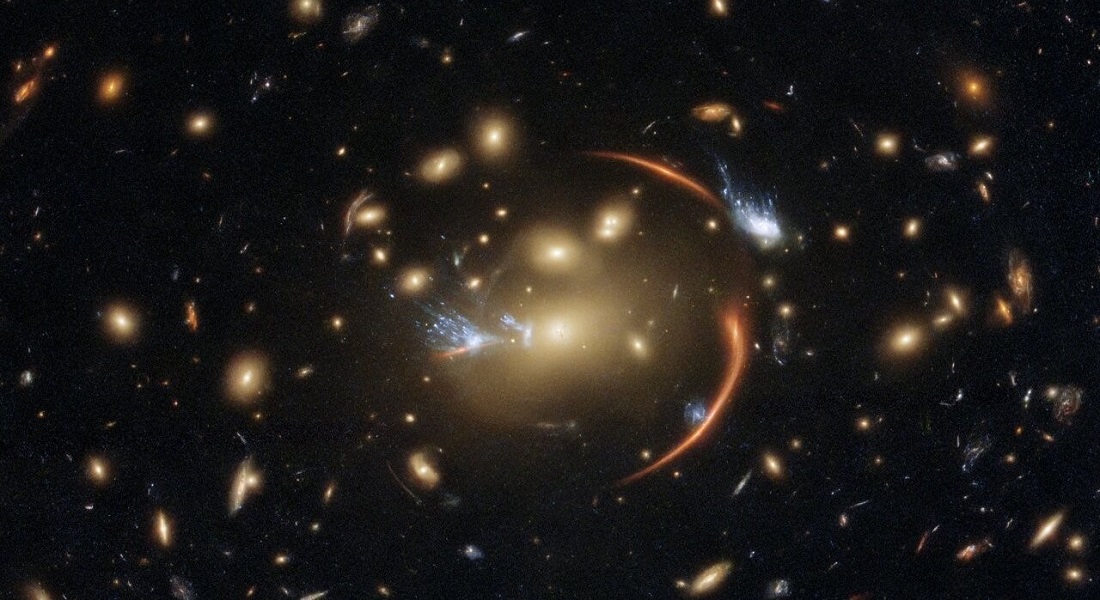Astronomers from the University of Copenhagen and the Technical University of Denmark (DTU), among others, have peered back 10-12 billion years into the universe and found six galaxies that mysteriously ran out of gas and suffered an unusually early death. The discovery was made possible by an astonishing cosmic phenomenon that gave the astronomers insight into these distant galaxies at an unprecedented level of detail.

Galaxies are said to 'die' when they run out of gas and stop forming stars. As with us humans, death typically comes knocking once we have grown old. But apparently, this is not always the case with galaxies, as new discoveries have shown.
A team of astronomers from the Cosmic Dawn Center at UCPH's Niels Bohr Institute and DTU Space, among others, have looked 10-12 billion years back in time and observed six massive galaxies that, at unusually young ages, depleted their gases and thereby stopped forming stars. Oddly, the six 'quenched' galaxies are found in a period of the early universe when star formation was at its peak. Consequently, the discovery challenges our understanding of star formation and the evolution of galaxies.
"At this point in the universe, 2-4 billion years after the Big Bang, all galaxies should be forming lots of stars. That is why it's a mystery that these six ran out of gas and died so early in their lives," explains astronomer and lead author Kate Whitaker of the Cosmic Dawn Center and the University of Massachusetts Amherst. The study has just been published in Nature.
Because light from distant galaxies takes so long to reach us, we peer further and further back in time the further away we look out into the universe.
Gasless galaxies are usually encountered by astronomers in the 'local' universe, where the oldest galaxies are found. The further we look into space, the fewer dead galaxies we encounter.
Marvelous phenomenon reveals cause of death
For a star to be born, two criteria must be met within a galaxy: the galaxy must contain enough hydrogen gas, and this gas must be cold, because hot gas clouds are unable to clump and collapse into stars.
However, observing gas in such far-flung galaxies is usually close to impossible because they are too faint and tiny to observe in sufficiently small details.
Nevertheless, Kate Whitaker and her colleagues succeeded thanks to a combination of three factors: the high resolution of NASA's Hubble Space Telescope, the powerful ALMA radio telescopes in Chile and a marvelous cosmic phenomenon known in astronomy as 'gravitational lensing'.
Gravitational lensing occurs when clusters of galaxies - in this case hundreds of galaxies - are located in front of a distant galaxy that one is seeking to observe. The enormous mass of these intervening galaxy clusters curves space itself to such a degree that it bends light from the more distant galaxies behind them down towards us. Such is the case with these six galaxies, where this 'cosmic magnifying glass' amplifies their light up to 30 times, allowing researchers to study them in an unprecedented degree of detail. Consequently, they were able to see that these galaxies had simply run out of gas.
"By using strong gravitational lensing as a natural telescope, we can find the distant, most massive and first galaxies to shut down their star formation", Kate Whitaker explains.
The discovery also confirms, once and for all, the theory that galaxies stop forming stars because they run out of gas.
"Our observations are so detailed that we are able to conclude that these galaxies ran out of gas. Indeed, we can see how much gas remains in a galaxy. In doing so, we've established the 'cause of death' of galaxies with a greater certainty than has ever been possible," states associate professor at Cosmic Dawn Center, Georgios E. Magdis.
Models come into play
The researchers' current models cannot explain this case of six galaxies forming so many stars in such a short period of time, only to rapidly expend all their gas.
However, Kate Whitaker ponders several possible explanations:
"Did a supermassive black hole in the galaxy's center turn on and heat up all the gas? If so, the gas could still be there, but now it's too hot. Was the gas blown out of the galaxy? Or did the galaxy simply use it all up? These are some of the open questions that we'll continue to explore with new observations down the road."
ABOUT THE STUDY
- To initially find the galaxies, astronomers harnessed the high resolution of NASA's Hubble Space Telescope. The observations which demonstrate that the galaxies had run out of gas were made using the powerful ALMA (Atacama Large Millimeter Array) radio telescopes in Chile.
- The survey leading to the discovery of the six dead galaxies is called Resolving QUIEscent Magnified (REQUIEM) Galaxies, and is based at the Cosmic Dawn Center.
- The research article has just been published in the journal Nature.
- The research was conducted by an international team of scientists. In addition to Kate Whitaker and Georgios E. Magdis, Sune Toft, Gabriel B. Brammer and Francesco Valentino from the Niels Bohr Institute at the University of Copenhagen contributed to the article.






